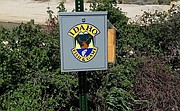Chinook on the hook
Spirit Lake anglers have another fish to chase, and the latest introduction to the lake should serve to reduce kokanee populations, which usually results in increasing the size of the small silver salmon.
Anglers last winter began catching chinook salmon through the ice, and the fish often tilted over the 20-inch margin, which is the catch and release cutoff.
Any chinook under 20 inches must be thrown back, according to state fishery laws, while fish over 20 inches can be kept. The chinook that anglers will catch and keep this summer will mostly be in the 20- to 24-inch range, said Carson Watkins of Idaho Fish and Game.
“It’s adding an exciting, new consumptive fishery to the lake,” Watkins said. “These chinook are landlocked. They do not migrate to the ocean but can still reach large sizes in waters with abundant kokanee.”
Chinook salmon, both fertile diploid fish and infertile triploids, were first stocked in the lake in the autumn of 2016 as part of a statewide study to determine which of the fish survive better and which variety is most often caught.
The two-pronged Spirit Lake study will also determine the effect of chinook on the lake’s kokanee fishery. If it’s successful, Fish and Game hopes chinook can be used as a way to make kokanee bigger as their populations are kept in check by chinook predation.
The size of a lake’s kokanee, also called blueback and silvers, usually depends on kokanee density. If numbers are high, greater competition for food keeps the size of the blueback smaller, while a lower density means bigger fish.
Sterile, or triploid, chinook provide biologists more control over the number of salmon. But sterile fish sometimes don’t survive as well as fertile fish. Fish and Game is asking for anglers’ help with the study by providing tissue samples from chinook they catch, Fish and Game fishery manager Andy Dux said.
He asks anglers to clip a small portion of a fin from a chinook — it can be the size of a hole punch. Anglers don’t need to harvest the fish to take a fin sample. The fin clip should be placed in an envelope and deposited in a drop box at the lake’s IDFG boat launch.
Watkins said the ice went off the lake earlier this month and fishing for chinook in the open water should start picking up.
The daily bag limit is two chinook and the minimum length limit is 20 inches.
Using spoons, spinners and flashers that look like kokanee is usually the best bet to catching chinook, Dux said.
“Trolling at depths where kokanee are abundant, and using gear that’s going to imitate kokanee is a good strategy,” he said.



